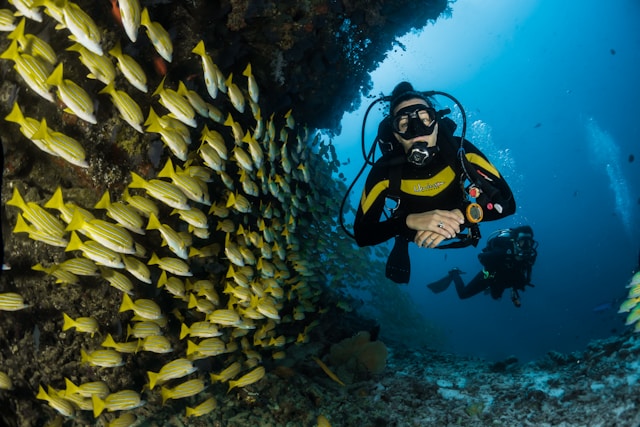
In technical SCUBA diving the mantra “plan the dive, dive the plan” is more than a catchy slogan—it is the first layer of life support. Before a single O‑ring touches the water, you should define clear objectives, calculate gas volumes, and program conservative decompression stops. Technical profiles often push beyond recreational limits—think 50‑metre trimix dives inside a rust‑ing wreck or long multi‑hour cave penetrations—so dive planning software such as MultiDeco, Subsurface, or Shearwater Cloud becomes indispensable for modelling inert‑gas loading, contingency gas reserves, and bailout routes.
Double‑check cylinder markings, regulator service records, and the compatibility of oxygen‑clean components with high‑O₂ mixes. Record everything in a written or digital pre‑dive checklist and run a full team brief that covers lost‑buddy protocols, lost‑line procedures, and hand‑signal confirmations. This disciplined groundwork not only minimises risk but also maximises bottom time efficiency—critical for scientific sampling, photogrammetry, or artifact recovery projects where every minute counts.
Essential Technical Skills for Safe Descent
Executing a deep or overhead dive safely hinges on skills honed long before you ever shoulder twinsets. Precision buoyancy control, non‑silting propulsion kicks (frog, modified flutter, back kick), and flawless trim keep your profile streamlined and your visibility intact in silt‑laden caves or wreck interiors. Drills such as gas‑share swims, valve shutdowns, and mask removals under simulated lights‑out conditions build the muscle memory required when valves free‑flow, lights fail, or a teammate suddenly needs your long hose. Dive educators like GUE, IANTD, and TDI stress “minimum decompression” hovering practice because rock‑solid buoyancy at six metres prevents micro‑bubble spikes that can turn a routine dive into a chamber ride. Remember that technical diving is a team sport; spend pool sessions perfecting team ascents, communication rhythms, and rescue tows so that roles feel instinctive once you descend into the dark zone where audible speech is impossible.
Equipment Considerations and Configuration
While recreational rigs focus on comfort, technical setups prioritise redundancy, modularity, and fault isolation. Back‑mounted doubles with an isolator manifold, dual independent sidemount cylinders, or a closed‑circuit rebreather (CCR) all solve the same problem: providing enough breathable gas—and options—when something inevitably breaks. Configure hoses and bolt‑snaps so that any teammate can read the pressure gauge, identify the long‑hose regulator, or locate the cutting tool without fumbling. Embrace “HOG” loop or Dir‑style hose routing to prevent snag points and simplify shutdowns. Carry at least two cutting devices (line‑knife and shears), a primary and backup computer capable of handling multiple gases, and a primary light plus two backups for overhead environments. Log battery cycles; lithium cells that die unexpectedly inside a historic U‑boat are more than an inconvenience—they may compromise your exit. Finally, invest in proper thermal protection suited to the mission: drysuit with redundant inflator, heated undersuits for cold‑water exploration, or lightweight rash guards for tropical cave systems where over‑heating on the surface is a real hazard.
Cultivating Respect Within the Global Dive Community
Technical diving attracts ambitious personalities, but humility and mutual respect are the true hallmarks of a seasoned tech diver. Respect starts with the environment—maintain perfect buoyancy to preserve delicate reef structures and avoid stirring ancient silt that can take decades to resettle. Log scientific finds responsibly and adhere to the “look but don’t touch” ethic when exploring virgin caves or culturally significant wrecks. Respect your teammates by showing up prepared, maintaining your kit, and being honest about your physical and mental readiness; a single fatigued diver can jeopardise the entire mission. Respect extends to training agencies and local regulations: if the site requires a permit, secure it. If a guide or park official sets limits, follow them—your compliance sustains access for future explorers. Finally, share knowledge generously. Posting accurate debriefs, gas‑mix data, and equipment insights on forums or at dive conferences helps raise community‑wide safety standards and nurtures the next generation of explorers.
Technical SCUBA diving is equal parts engineering discipline, athletic skill, and community stewardship. A robust dive plan provides the blueprint; refined in‑water skills execute that plan; purpose‑built equipment mitigates mechanical failures; and a culture of respect keeps both people and the underwater world safe. Whether you are plotting your first 40‑metre deco dive or surveying a deep cave system on CCR, internalise these pillars. They are not merely best practices; they are the difference between a successful mission and a headline in tomorrow’s accident report. Hone them relentlessly, and every descent will become not just a thrill but a masterclass in underwater professionalism.